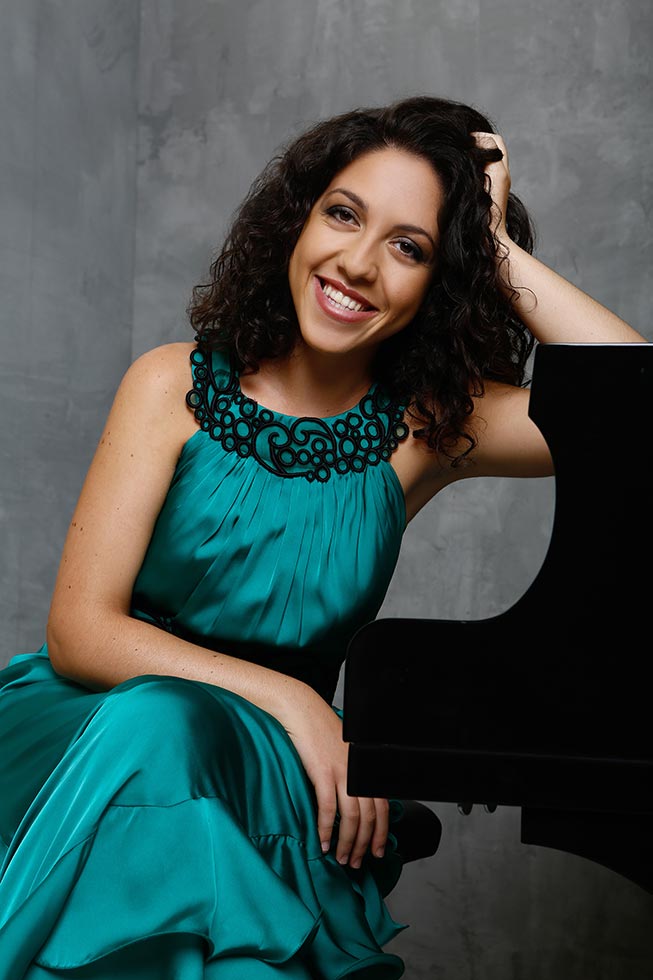As pianist Beatrice Rana ran up the final bars of Schumann’s Piano Concerto, the conductor Mirga Gražinytė-Tyla turned to her soloist and simply beamed. As well she might. Rana is an artist whose advance publicity belies the seriousness and selflessness of her playing. Her Schumann didn’t concern itself with flashy effects (though there were some daring variations of tempo) or even, particularly, beauty of tone (though the iridescent glow she gave to the little cascades of chords that link the Intermezzo to the finale showed that she commands an impressive palette).
Rana’s performance was more concerned with counterpoint than colour; a brisk, earnest, intensely sincere approach which let Schumann’s poetry speak for itself. And with Gražinytė-Tyla and the City of Birmingham Symphony Orchestra in alert, warm-hearted support, that was enough to release one of the most unaffectedly musical performances of this concerto we’ve heard. In any other concert, it would have been the main talking-point (Rana pictured below by Marie Staggat)
But it’s no secret that the CBSO is currently searching for a new music director, and it’s been known since last summer that Gražinytė-Tyla is – at the very least – under serious consideration. This concert was arranged at short notice outside of the orchestra’s main season; that alone – plus the fact that a further concert has quietly been arranged next weekend with the young Israeli conductor Omer Meir Wellber (online rumours that another Israeli, Lahav Shani, is still in consideration can be discounted) - couldn’t help but create an atmosphere of expectation.
 What Gražinytė-Tyla achieved, then, was all the more remarkable. Her ultra-precise beat and balletic podium manner have attracted unfavourable comment from people who fundamentally misunderstand how an orchestra responds to a conductor – or who simply can’t listen. That Gražinytė-Tyla has a distinctive vision – and the power to realise it – was obvious from the rapturous opening bars of Debussy’s Prélude à l’après-midi d’un faune in which she coaxed the strings to match both the colour and texture of Marie-Christine Zupancic’s daringly-soft opening flute solo, and went on to generate an unfolding sense of wonder in which even the rests felt like part of the phrasing: hanging, pregnant with expression, in a breathlessly quiet Symphony Hall.
What Gražinytė-Tyla achieved, then, was all the more remarkable. Her ultra-precise beat and balletic podium manner have attracted unfavourable comment from people who fundamentally misunderstand how an orchestra responds to a conductor – or who simply can’t listen. That Gražinytė-Tyla has a distinctive vision – and the power to realise it – was obvious from the rapturous opening bars of Debussy’s Prélude à l’après-midi d’un faune in which she coaxed the strings to match both the colour and texture of Marie-Christine Zupancic’s daringly-soft opening flute solo, and went on to generate an unfolding sense of wonder in which even the rests felt like part of the phrasing: hanging, pregnant with expression, in a breathlessly quiet Symphony Hall.
Sibelius’s four Lemminkäinen Legends made good on the Debussy’s promise. Gražinytė-Tyla has a powerful sense of the single culminating point of a large-scale musical structure, and the idea that these four tone-poems add up to a thinly-disguised symphony has rarely felt so convincing, with Gražinytė-Tyla reversing the conventional order of the two central pieces so that Lemminkäinen in Tuonela became a slow, macabre scherzo, and the dying notes of The Swan of Tuonela served as a sort of prelude to the first drumbeats of Lemminkäinen’s Homecoming. Throughout, Gražinytė-Tyla drew out and relished each fantastical detail of Sibelius’s scoring: snare-drum rattling against a pianissimo rustle of violins, the gurgling woodwind laughter of the maidens of Saari, and the impressionistic blur of sound that introduced Rachael Pankhurst’s tender, improvisatory cor anglais solo in The Swan of Tuonela.
And yet the pacing remained taut, the cumulative build-up and release of energy overwhelming – and the players, leaning into their stands and exchanging discreet smiles, seemed energised. They, rather than any manager or critic, will have the final say on their new music director, and it’s probably premature to expect any white smoke to emerge from CBSO Centre in the immediate future. What’s clear is that Gražinytė-Tyla has a lively intelligence, a commanding technique and – most importantly – a joyous natural musicality that in the right conditions could more than fill the shoes of Nelsons, Oramo and Rattle. Any orchestra would be lucky to have her.















Add comment